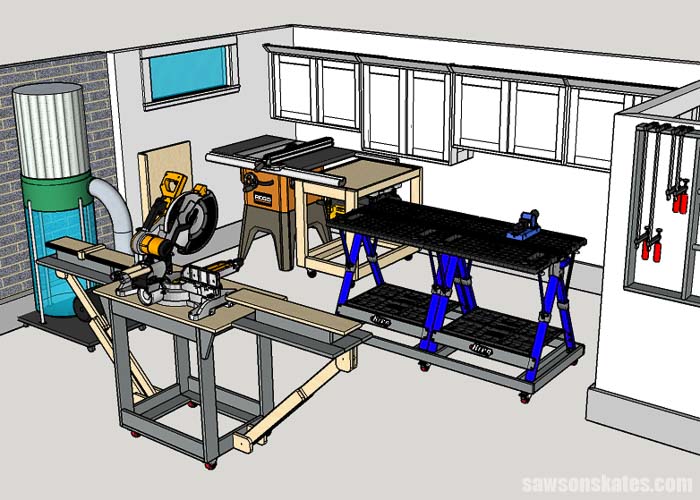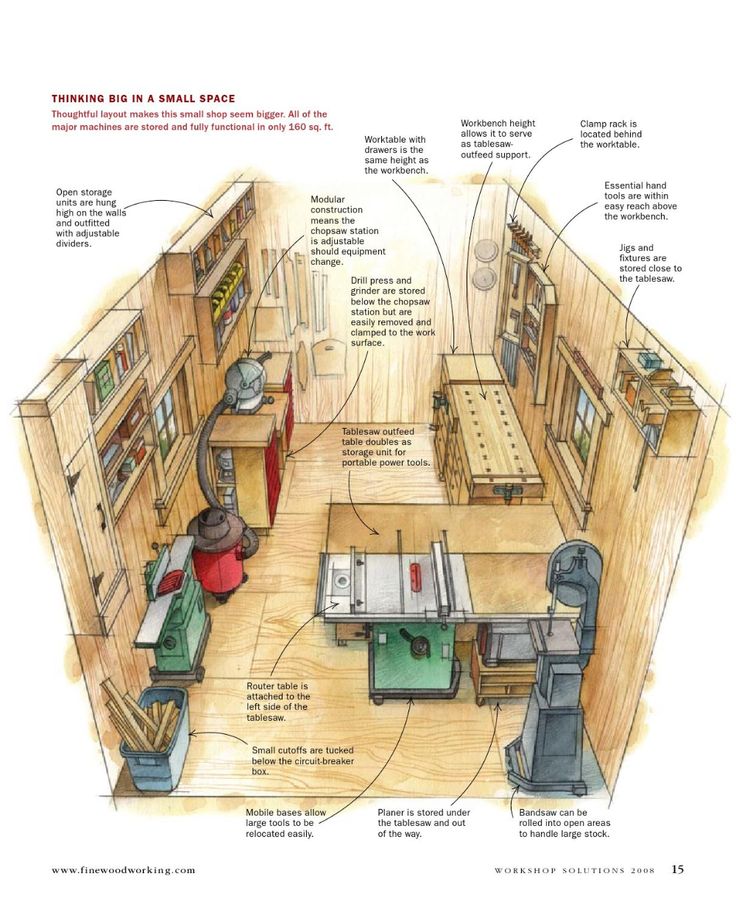Small woodworking shop layout plans are crucial for optimizing space and workflow efficiency. These plans detail the arrangement of tools, workstations, and storage areas to enhance productivity.
By strategically organizing the layout, woodworkers can maximize their space and create a functional and ergonomic environment for crafting projects. Planning ahead and considering factors such as workflow, tool accessibility, and safety can help create an efficient woodworking shop that meets the specific needs of the woodworker.
In this blog post, we will explore key tips and considerations for designing a small woodworking shop layout that promotes efficiency and creativity.
Introduction To Small Woodworking Shops
Small woodworking shops are a haven for crafters and DIY enthusiasts, providing a space where creativity and craftsmanship come together. Whether you’re a novice woodworker or a seasoned pro, the layout of your workshop plays a crucial role in maximizing efficiency and productivity. In this guide, we’ll delve into the world of small woodworking shop layout plans, exploring why small spaces are ideal for woodworking and the importance of a well-thought-out layout.
Why Small Spaces?
Small woodworking spaces offer a cozy and intimate setting that encourages focus and creativity. Limited square footage also forces woodworkers to maximize every inch, leading to innovative storage solutions and efficient use of tools and machinery. Additionally, small shops are often more cost-effective to set up and maintain, making woodworking accessible to a wider audience.
The Importance Of Layout
An efficient woodworking shop layout is essential for streamlining the production process and minimizing wasted time and effort. A well-organized layout ensures that tools, workbenches, and storage areas are strategically positioned for easy access, promoting a smooth workflow and reducing the risk of accidents. Optimizing the layout also facilitates a clear and clutter-free environment, fostering a sense of calm and focus while working on intricate woodworking projects.

Credit: www.youtube.com
Essential Tools For Your Shop
When it comes to setting up a small woodworking shop, having the right tools is essential. Whether you’re a beginner or a seasoned woodworker, having a well-equipped shop can make all the difference in the success of your projects. In this article, we will explore the must-have power tools and hand tools that can help you save space in your small woodworking shop.
Must-have Power Tools
Power tools can significantly enhance your woodworking capabilities, allowing you to tackle a wide range of projects with ease. Here are some must-have power tools for your small woodworking shop:
- Table Saw: A table saw is a versatile tool that can be used for ripping, cross-cutting, and making various types of cuts. It is the heart of any woodworking shop.
- Compound Miter Saw: This saw is perfect for making accurate crosscuts and miter cuts. It can handle both straight and angled cuts, making it a valuable addition to your shop.
- Router: A router is a versatile tool that can be used for shaping edges, cutting grooves, and creating decorative profiles. It is a must-have tool for any woodworker.
- Drill Press: A drill press is essential for making accurate holes in wood. It provides precision and control, making it easier to create perfect holes for joinery and other woodworking tasks.
- Random Orbital Sander: This sander is perfect for smoothing out surfaces and removing imperfections. It is a powerful tool that can save you a lot of time and effort in the sanding process.
Hand Tools That Save Space
Hand tools are essential for any woodworking shop, and they can be a great space-saving alternative to larger power tools. Here are some hand tools that are perfect for small woodworking shops:
- Hand Planes: Hand planes are versatile tools that can be used for smoothing, shaping, and removing material. They are compact and don’t require a power source, making them a great space-saving option.
- Chisels: Chisels are essential for precision work, such as creating joints and carving details. They come in various sizes and can be easily stored in a small workshop.
- Japanese Pull Saw: This saw is perfect for making accurate cuts and can be used for both crosscuts and rip cuts. It is compact and easy to maneuver, making it ideal for small spaces.
- Clamps: Clamps are essential for holding pieces together while the glue dries. They come in various sizes and styles, allowing you to choose the right ones for your projects.
- Marking and Measuring Tools: Measuring tapes, squares, and marking gauges are essential for accurate measurements and layout. They are compact and can be easily stored in a small woodworking shop.
By incorporating these must-have power tools and space-saving hand tools into your small woodworking shop, you can maximize your efficiency and tackle a wide range of projects. Remember, investing in quality tools will not only make your woodworking journey more enjoyable but also ensure the best possible results.
Planning Your Layout
When it comes to setting up a small woodworking shop, effective planning is crucial. This starts with carefully considering the layout of your space to optimize workflow and functionality. In this article, we’ll dive into the key aspects of planning your layout, including space analysis and workflow considerations.
Space Analysis
Before diving into your small woodworking shop layout plans, it’s essential to conduct a thorough space analysis. Measure the dimensions of your shop, taking into account the height, width, and length. Create a detailed floor plan that includes existing obstacles such as support columns, doorways, and windows.
Workflow Consideration
Optimizing the workflow in your woodworking shop is crucial for efficiency and productivity. Consider the natural flow of work, from raw material storage to the finished product. Organize your tools and machinery in a way that minimizes unnecessary movement and maximizes accessibility.
Maximizing Vertical Space
When designing a small woodworking shop layout, maximizing vertical space is crucial for efficiency.
Shelving Solutions
Utilize adjustable shelving units to accommodate different-sized tools and materials.
- Optimize space by grouping similar items together on shelves.
- Label each shelf for easy identification of tools and supplies.
Wall-mounted Tool Organizers
Install pegboards or slat walls to hang frequently used tools within arm’s reach.
- Arrange tools by size to maximize wall space efficiently.
- Consider magnetic strips for holding metal tools securely.
Mobile Bases And Workstations
When it comes to setting up a small woodworking shop, one of the key considerations is the layout and organization of the space. Having a mobile base and workstation can provide numerous benefits, allowing you to optimize your workflow and make the most of the available space. In this section, we will explore the advantages of mobility in a woodworking shop and share some DIY mobile base ideas to help you create a functional and efficient workspace.
Benefits Of Mobility
Having mobile bases and workstations in your woodworking shop can greatly enhance your productivity and flexibility. Here are some key benefits:
- Maximizing Space: By incorporating mobility into your shop layout, you can easily rearrange your equipment and workstations as needed, making the most efficient use of the available space.
- Improved Workflow: Mobile bases allow you to move heavy machinery and tools around your shop, reducing the need for excessive lifting and saving you valuable time and effort.
- Adaptability: With mobile workstations, you can easily adjust the layout to accommodate different project sizes and requirements. This adaptability enhances your ability to work on various projects without feeling restricted by fixed workstations.
- Organization: Mobile bases and workstations can help you keep your shop organized by providing designated spaces for different tools and materials. This helps prevent clutter and ensures that everything has its place, making it easier to find what you need when you need it.
Diy Mobile Base Ideas
If you’re looking for cost-effective solutions to add mobility to your woodworking shop, here are some DIY ideas to consider:
- Rolling Tool Carts: Build sturdy and compact tool carts with wheels, allowing you to move your frequently used tools around the shop effortlessly.
- Mobile Workbenches: Construct workbenches with built-in wheels, enabling you to move them around as needed and create additional workspace wherever required.
- Portable Storage Units: Design and build portable storage units on wheels to keep your supplies and materials organized and easily accessible.
- Foldable Workstations: Create foldable workstations that can be easily moved and stored when not in use, providing you with extra space when needed.
By incorporating these DIY mobile base ideas into your woodworking shop, you can enjoy the flexibility and efficiency that comes with a mobile workspace, all while optimizing the functionality of your small shop layout.
Efficient Storage Solutions
Discover efficient storage solutions for your small woodworking shop with our expertly designed layout plans. Maximize your space and optimize your workflow with smart organization ideas that will help you make the most of your woodworking projects.
Small woodworking shops require efficient storage solutions to maximize the use of the limited space available. Proper storage solutions not only help in keeping the shop organized but also help in increasing productivity. In this post, we will discuss some efficient storage solutions for small woodworking shop layout plans.Under-workbench Storage
Under-workbench storage is an excellent way to utilize the space under your workbench. You can use this space to store hand tools, power tools, and other small items. You can either build drawers or install cabinets to store the items.Clever Cabinet Ideas
Cabinets are essential for any woodworking shop, and there are many clever cabinet ideas that you can use to maximize storage space. One idea is to install cabinets with adjustable shelves to store materials of different sizes. Another idea is to install a pegboard on the inside of a cabinet door to hang small items. You can also install a lazy Susan in a corner cabinet to store small items that are difficult to reach.Other Storage Solutions
Apart from under-workbench storage and cabinets, there are other storage solutions that you can use in your small woodworking shop. You can install shelves on the walls to store items that are frequently used. You can also use hanging storage solutions to hang items like clamps, saw blades, and drill bits. Efficient storage solutions are essential for any small woodworking shop. With proper storage solutions, you can make the most out of the limited space available and increase productivity. Use the above storage ideas to help you maximize your storage space and keep your woodworking shop organized.Dust Collection And Ventilation
When setting up a small woodworking shop, paying attention to dust collection and ventilation is crucial for creating a safe and efficient workspace. Proper dust collection systems not only help in maintaining a clean and organized shop but also contribute to a healthier working environment. Additionally, effective ventilation ensures the circulation of fresh air, reducing the risk of airborne particles and improving overall air quality.
Compact Dust Collection Systems
Compact dust collection systems are essential for small woodworking shops where space is limited. These systems efficiently capture and contain sawdust, wood chips, and other debris, preventing them from accumulating on surfaces and in the air. Investing in a compact dust collection system not only helps in maintaining a tidy workspace but also promotes a healthier environment for woodworkers.
Improving Air Quality
Improving air quality in a woodworking shop is vital for the health and well-being of the woodworkers. By implementing effective dust collection and ventilation strategies, airborne particles and harmful fumes can be minimized, leading to a safer and more comfortable working environment. Regular maintenance and cleaning of dust collection systems contribute to sustaining improved air quality within the shop.
Real-life Layout Examples
Discover real-life layout examples for small woodworking shop layout plans. Explore practical designs to optimize space efficiently.
Small Shop Tours
Lessons Learned
Final Thoughts
Consider these small woodworking shop layout plans to optimize your space for efficiency and productivity. Organizing tools and machinery strategically can maximize workflow and safety, making the most of your small woodworking shop. With thoughtful planning, you can create a functional and inspiring workspace.
Adapting To Your Space
Creating a small woodworking shop is all about making the most of the space you have. There are many different small woodworking shop layout plans to choose from, but the most important thing is to find one that works for your specific space. This means adapting the plan to fit your needs and the size and shape of your workshop. One of the best ways to do this is to use portable tools and equipment that can be easily moved around your shop. This will help you maximize your space and make the most of every inch. You can also use vertical space by installing shelves and cabinets to store your tools and supplies.The Journey To An Efficient Workshop
Creating an efficient woodworking shop takes time and effort, but it’s worth it in the end. The key is to start with a solid plan and then make adjustments as you go along. This means taking the time to organize your tools and supplies, and creating a layout that works for you. Another important factor is to keep your shop clean and tidy. This not only makes it easier to work, but it also helps you stay safe. Make sure to have a designated area for dust collection and invest in a good air filtration system. In addition, you should always be looking for ways to improve your shop and make it more efficient. This means staying up-to-date on the latest tools and techniques, and being open to new ideas and approaches. Creating a small woodworking shop is a challenging but rewarding process. By adapting to your space and focusing on efficiency, you can create a workshop that is both productive and enjoyable to work in. Remember, the key is to start with a solid plan and then make adjustments as you go along. With time and effort, you can create a woodworking shop that meets all of your needs and helps you achieve your goals.
Credit: sawsonskates.com

Credit: www.pinterest.com
Frequently Asked Questions
How To Layout A Small Wood Shop?
To layout a small wood shop, follow these guidelines: 1. Plan the layout according to the available space and the workflow. 2. Prioritize safety by ensuring clear pathways and proper ventilation. 3. Organize tools and materials for easy access and efficient use of space.
4. Consider the placement of workbenches, storage shelves, and machinery. 5. Optimize the layout for productivity and comfort to create a functional and efficient small wood shop.
What Is A Good Size For A Hobby Woodworking Shop?
A good size for a hobby woodworking shop is around 200 to 600 square feet, depending on your equipment and projects. It should provide enough space for tools, workbenches, and movement while allowing for future expansion. Keep it organized and functional for a comfortable working environment.
What Is A Good Workshop Layout?
A good workshop layout should prioritize functionality and efficiency. It should allow easy movement of tools and equipment and provide ample space for workstations. The layout should also consider safety measures and ensure proper ventilation and lighting. Lastly, it should be well-organized and clutter-free to minimize distractions and improve productivity.
How To Make A Workshop Layout?
To make a workshop layout, plan the space, consider workflow, allocate zones for tools, machinery, and workstations. Ensure proper lighting, ventilation, and safety measures. Optimize storage and organization for efficiency. Keep the layout flexible for future adjustments.
Conclusion
In crafting a small woodworking shop layout, thoughtful planning ensures optimal functionality and efficiency. By strategically organizing tools and workspaces, woodworkers can enhance productivity and creativity in their craft. Implementing a well-designed layout will streamline workflow and enhance the overall woodworking experience.
Start creating your dream workshop today.



